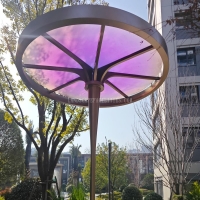Welcome to the website for landscape facilities products and knowledge.
How does the table’s design support ease of use in outdoor meditation spaces?
The integration of a table into an outdoor meditation space is a subtle yet profound design consideration that significantly enhances the practice's ease of use. A well-conceived meditation table is not merely a surface but a functional anchor that supports a seamless and intuitive experience. Its design directly addresses the practical needs of a practitioner while harmonizing with the natural environment.
Firstly, the table's height and proportions are paramount. It is typically designed to be lower than a standard table, aligning with the seated position of a meditator on a cushion or bench. This ergonomic consideration eliminates unnecessary stretching or straining, allowing for easy access to items like a meditation bell, incense, or a water vessel without breaking a contemplative posture. The surface area is intentionally restrained, discouraging clutter and promoting a minimalist aesthetic that is conducive to focus. A table that is too large becomes a distraction; one that is too small is impractical. The ideal design finds a balance, offering just enough space for essential items.
Secondly, the choice of material is critical for both durability and tactile experience. In an outdoor setting, the table must withstand sun, rain, and wind. Materials like teak, cedar, or polished concrete are not only weather-resistant but also age gracefully, acquiring a patina that deepens their connection to the natural world. The texture of the surface is equally important. A smooth, cool stone can be grounding on a warm day, while the warm grain of wood provides a soft, organic touch. This materiality supports ease of use by being low-maintenance and inviting interaction, requiring no special covers or constant care.
Furthermore, the table's layout and ancillary features contribute significantly to its user-friendliness. A design that incorporates a slight lip or rim can prevent objects from sliding off in a gentle breeze. Some tables may include a discreet, integrated channel for routing cables from a small speaker for guided meditations, keeping the space tidy and safe. The placement of the table within the meditation space is also a part of its design intelligence. It should be positioned for convenient reach but not as a central focal point, ensuring that the primary attention remains on the practitioner's inner experience.
Ultimately, a table in an outdoor meditation space succeeds when its design becomes almost invisible. It serves its purpose so effortlessly that it does not pull attention away from the practice itself. By prioritizing ergonomic height, resilient and sensory materials, and intuitive features, the table transforms from a simple piece of furniture into a vital support system. It fosters an environment where the transition into a meditative state is fluid, uninterrupted by practical inconveniences, thereby fully supporting the ease of use and deepening the overall practice of mindfulness in the open air.
Related search:

Recommendation
Metal frame with gradient color acrylic combined with high-end shading landscape facilities